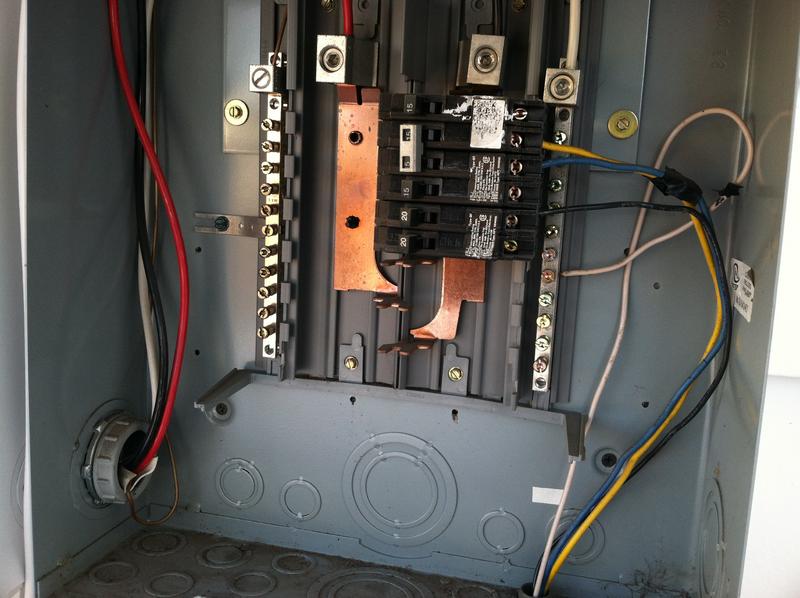Need some advise on the blue and yellow conductor in a 50 amp sub panel. The blue and yellow conductor on the 15 amp double pole breaker was attached to a single baseboard heater. The black and white conductor on the 20 amp breaker was attached to an exterior light and exterior GFCI receptacle. Does not appear to be any ground conductor? Am I missing something?
First picture is of the General Electric main service panel (notice mismatched breakers). Second picture is of a Siemens sub panel.
Blue and yellow are usually pulled through conduit. The conduit could be acting as your EGC. What material is it?
Not a concern. Blue and yellow are acceptable for hots, though they are typically coded for 3 or 4-way switch travelers or switch legs on lights, outlets, etc. respectively.
Makes senses know. The conductors were routed through a metal conduit. Thank you.
A ungrounded conductor can be just about any color except for the ones designated for a grounded conductor or EGC. Is this outdoors? The NM cable in the offset nipple is technically a violation.
Looks like the blue and yellow are on tandem breakers and therefor are on the same phase, which would not be correct for a 220 line with handle ties attached
The yellow and blue are usually used as hots in three-phase system, so I would normally say that these show habits of a commercial electrician, but the work does NOT look professional at all.
However, to answer the OP question, yellow and blue are “kosher” as hot conductors.
I would call out that NM per Robert Meier’s post, as well as the armored cable sticking straight up from the bottom of the box in picture 1; When terminated properly, the armor would never be showing inside the panel.
I’m sure there are more violations, but I realize that it was not the question.
I see a couple concerns in this panel if i may…
Please see my notes below…
The biggest safety violation(s) I see are as follows:
#1 The lugs that are being used for the main feeding the panel are big and may (or may not) be rated for the size of wire that is under them.
and #2 the possible lack of grounding path for a fault out to your branch circuits.
I also agree with the previous statement that both of these panels were installed by a homeowner and I would suggest a licensed electrician look the install.
On the first panel: I too agree with previous comment. The armored cable is inproperly installed which again is a safety concern due to lack of proper bonding of the armored cable.
THe main breaker is required to have a “breaker retainer clip” installed. This appears to be your main right off of the meter… so the bond jumper is ok on the left side of the panel…
One last statment… I don’t see any ground wires leaving with the branch circuits. This could be a huge safety concern.
I would advise making sure to at minimum use a plug tester on the outlets to verify grounds are present througout the house.
Well After reviewing my comments and previous, I didn’t add too much to the conversation; but what little input I added I hope is useful.
Very useful Nathan as some may not see the additional information needed. I agree with everything but the ground check. Seeing the problems existing here I would not grant that the ground is correct at each plug and may have boot leg grounds thus giving you a wrong picture.
Depending on the age of installation, the lack of grounding to branch circuits as seen in the panel is not necessarily a defect.
If this panel had fuses you might be correct but I think having breakers,
I do not think it is old enough to not have grnds
Having breakers or fuses would not be enough to indicate/determine lack of ground (2 wire or 3 wire), or if an EGC was required at time of panel installation. At least not in the US.
Even if a metallic raceway wasn’t being used as an EGC it would still be required to be grounded. If the metal raceways in the photo’s were properly installed then why would there be a question about an EGC for the branch circuits?
Very good point… and very true… good call.
And as Robert said the branch circuits should be grounded. Unless everything is protected by GFCI’s then older systems that have been updated(in some cases) are allowed to not have grounding.
Is the GFI receptacle rated for a 15 amps circuit or is the T-slot type rated for 20 amps, just wondering.
Both are rated for 20 amp feedthrough. The 20 amp slots are rarely needed.

